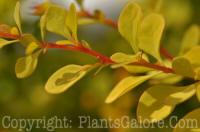
 This is a very large genus with hundreds of
species and there is a lot of disagreement among
taxonomists as to just how many
Berberis and
Mahonia (grape holly) species belong in
which genus. They are native to many different
temperate and
tropical regions of the world.
This is a very large genus with hundreds of
species and there is a lot of disagreement among
taxonomists as to just how many
Berberis and
Mahonia (grape holly) species belong in
which genus. They are native to many different
temperate and
tropical regions of the world.
The
barberries are thorny shrubs, with alternate
leaves (both deciduous and evergreen types), bright
yellow (but not showy) flowers and red, yellow, blue or black
fruits. The leaves of the evergreen types may
resemble those of Ilex (Holly).
 Generally,
barberries are tolerant of a wide variety of
soil and site conditions. They can take both sun
and shade and have traditionally been used
widely as a foundation plant.
Generally,
barberries are tolerant of a wide variety of
soil and site conditions. They can take both sun
and shade and have traditionally been used
widely as a foundation plant.
Some (especially
the common barberry, Berberis vulgaris) are not legal to plant because they
act as an alternate host for the very
destructive black stem rust disease of wheat. The
species commonly used in the landscape are immune or
highly resistant to this disease.
bnb



